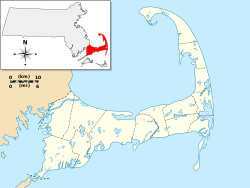
The Point Montara Light is a lighthouse in Montara, California, United States, on the southern approach to the San Francisco Bay, California approximately 25 miles south of San Francisco.

The Ahearn House and Summer House are a pair of houses at 450 Pamet Point Road in Wellfleet, Massachusetts. The smaller "summer house" is an early 19th-century cottage, while the main house is a subsequent construction; both are important examples of period architecture in the community. The property was listed on the National Register of Historic Places in 1984.

The Atwood–Higgins Historic District encompasses a historic property with deep colonial roots in Cape Cod National Seashore. Located on Bound Brook Island on the west side of Wellfleet, Massachusetts, the centerpiece of the district is the Thomas Atwood House, built c. 1730. The property is emblematic of Cape Cod's colonial origins and its later transformation into a summer resort area. The house was listed on the National Register of Historic Places in 1976; the district was listed in 2010. The property is open for guided tours by the National Park Service on a seasonal basis.

The Wellfleet Center Historic District is a historic district in Wellfleet, Massachusetts. It encompasses resources that exemplify the development of the community, beginning in the late 18th century, as a thriving commercial maritime center, and then its rise as a summer resort community in the late 19th century. Buildings in the district include Cape-style houses from the mid-18th century, 19th century commercial and institutional buildings in the town center, and the 1880s summer estate of Lorenzo Dow Baker. The district is roughly bounded by Cross St., Holbrook Ave., Main, E. Main and School Streets, and Duck Creek, and was listed on the National Register of Historic Places in 1989.
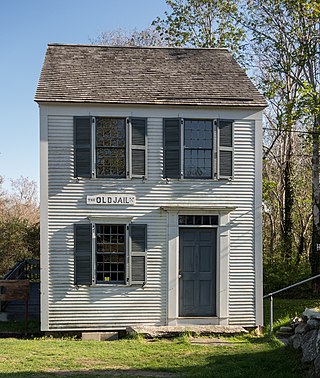
Barnstable's Old Gaol is a historic colonial jail in Barnstable, Massachusetts. Built c.1690, it is the oldest wooden jail in the United States of America.
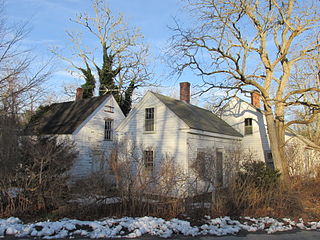
The Hinckley's Corner Historic District, also known as Paine Hollow, is a historic district including three properties located at 0, 25, and 40 Way #112 in Wellfleet, Massachusetts. This small cluster of properties are a representative of the outer Cape's life in the 19th century. All three houses are fairly utilitarian 1-1/2 story Cape style houses, with only modest traces of late Georgian or Federal styling. The oldest house, the Jonathan Young House at 40 Way #112, was built c. 1790-91, and was owned for a significant portion of the 19th century by members of the Hinckley family. This property includes a 19th-century barn, a c. 1920 structure whose uses have included a retail store and an art studio, and a c. 1950 garage. The John Lewis House at 25 Way #112 was built c. 1820, and has a Federal style fanlight over the main entrance. Its property includes a garage/guesthouse built c. 1924, originally to house a Model T firetruck, and an oysterhouse built 1827-28.
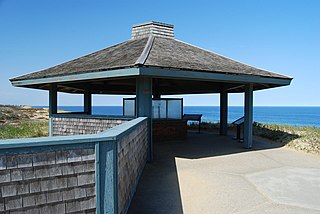
The Marconi Wireless Station Site in South Wellfleet, Massachusetts, USA is the site of the first transatlantic wireless communication between the United States of America and Europe, on January 18, 1903. At this location, now part of the Cape Cod National Seashore, inventor Guglielmo Marconi erected a large antenna array on four 210-foot (64 m) wooden towers, and established a transmitting station powered by kerosene engines that produced the 25,000 volts of electricity needed to send signals to a similar station in Poldhu, Cornwall, United Kingdom. The first transmission received on the continent of North America by Marconi was at Signal Hill, St. John's, Newfoundland and Labrador in 1901; Glace Bay, Nova Scotia was the site of the first such two-way transmission, in 1902.
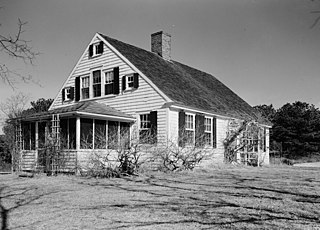
The John Newcomb House is a historic house in Wellfleet, Massachusetts. It is best known as the house described by Henry David Thoreau in the chapter on the "House of the Wellfleet Oysterman" in his 1865 book, Cape Cod. The house is located in Cape Cod National Seashore, on a sandy lane off Gull Pond Road to the east of Williams Pond in northern Wellfleet. The Cape style house is presumed to have been built by John Y. Newcomb.
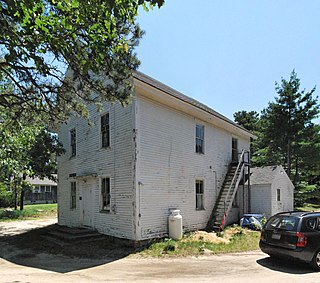
The Pond Hill School is a historic school building at 65 Old Paine Hollow Road in Wellfleet, Massachusetts. The plain Greek Revival two story schoolhouse was built in 1857, and is the only period schoolhouse in Wellfleet to survive relatively intact. The building served as a schoolhouse until 1880, and was purchased six years later by the South Wellfleet Ladies Social Union. In 1945, with that organization in decline, the property was given to a neighborhood association, which maintains the building.

The Townsend House is a historic house at 290 Paine Hollow Road in Wellfleet, Massachusetts. The 1+1⁄2-story full Cape style wood-frame house was built in 1804, probably by Doctor James Townsend, whose descendants owned the house well into the 20th century. The most notable resident was Samuel Campbell, an English engineer who worked with Guglielmo Marconi on the transatlantic wireless facilities in Wellfleet. The house is notable as a particularly little-altered example of the style, with details typically only found in houses of wealthier owners. The house was listed on the National Register of Historic Places in 1998.
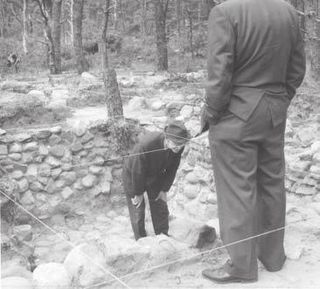
The Samuel Smith Tavern Site is a historic archeological site in Wellfleet, Massachusetts, United States. It encompasses the remains of a late 17th-century tavern operated by Samuel Smith, owner of Great Island, which shelters Wellfleet Harbor. The tavern site is located within the Cape Cod National Seashore, and is accessible via the Great Island Trail. The site was excavated in 1969–70, recovering thousands of artifacts, including clay pipes, drinking artifacts, a harpoon, and a chopping block fashioned from whale vertebrae.

The Saunders–Paine House is a historic house at 260 Paine Hollow Road in Wellfleet, Massachusetts. This 1+1⁄2-story Federal style Cape was built c. 1830, and is a well-preserved local example of the style. The first known owner was Charles Saunders who married Mary Cole Paine, whose family gave the area its name. The house was listed on the National Register of Historic Places in 1998.
Hatch House may refer to the following houses in the United States:
The Cape Cod Modern House Trust is a non-profit historic preservation organization working to preserve and interpret Modern period houses built on Cape Cod in the U.S. state of Massachusetts. The organization describes its mission to ''promote the documentation and preservation of significant examples of Modernist architecture on the Outer Cape."

The Ruth and Robert Hatch Jr. House is a historic house at 309 Bound Brook Way in Wellfleet, Massachusetts. It is one of a modest number of surviving houses in Wellfleet that combine elements of Modern architecture with traditional Cape Cod architecture. This single story wood-frame house was built in 1961 on Bound Brook Island to a design by local architect Jack Hall. Extremely rustic in appearance, its exterior is sheathed in vertical boards and its windows have working shutters but no glass, resulting in a sharply vertical appearance. The structure consists of three rectangular sections of different sizes that are based on modular 7' by 7' squares; the main public living space is 35' by 49', the master bedroom is 7' by 21', and the guest bedrooms are in a block that is 7' by 14'. The house, which is within the bounds of the Cape Cod National Seashore, was sold by the Hatches to the National Park Service, but they retain occupancy rights.

The Samuel and Minette Kuhn House is a historic house in Wellfleet, Massachusetts. It is one of a modest number of surviving houses in Wellfleet that combine elements of Modern architecture with traditional Cape Cod architecture. The single-story wood-frame house was built in 1960 to a design by Nathaniel Saltonstall, founder of Boston's Institute of Contemporary Art. The Kuhns were exposed to Saltonstall's work when they stayed at The Colony, another property he designed that is located nearby on Griffins Island. The house incorporates Bauhaus design principles of simplicity and economy, and is based around the idea of square modules, which are repeated on small, medium and large scales, affecting the room shapes and sizes, windows, and interior furnishings and decorations. The house, which is within the bounds of the Cape Cod National Seashore, was sold by the Kuhns to the National Park Service in 1973, but they retained right of occupancy for 25 years. The Park Service began using the property for employee housing in 2003.
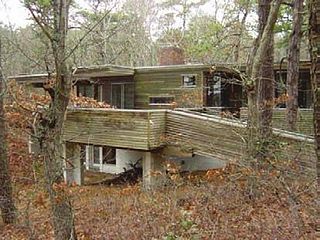
The Peter Kugel House, also known as the Kugel-Gips House, is a historic house at 188 Way 626, Wellfleet, Massachusetts, in Cape Cod National Seashore. It is one of a modest number of surviving houses in Wellfleet that combine elements of Modern architecture with traditional Cape Cod architecture. This house was built in 1970 to a design by architect Charlie Zehnder, who took his design inspiration for it from the Fallingwater estate designed by Frank Lloyd Wright.

The Anthony and Allison Sirna Studio is a historic artist's studio at 60 Way #4 in Wellfleet, Massachusetts. It is one of a modest number of surviving buildings in Wellfleet that combine elements of Modern architecture with traditional Cape Cod architecture. The studio was built in 1960 to a design by Victor Civkin; it has a trapezoidal plan with nine large vertical window bays. The building is within the bounds of the Cape Cod National Seashore, and is owned by the National Park Service.

The Paul and Madeleine Weidlinger House, also known simply as the Weidlinger House, is a historic house at 54 Valley Road in Wellfleet, Massachusetts. It is one of a modest number of surviving houses in Wellfleet that combine elements of Modern architecture with traditional Cape Cod architecture. The single story wood-frame house was built in 1954 by designer Paul Weidlinger for his family's use. It is located on a steep grade overlooking Higgins Pond, with one end projecting over the grade. A deck wraps around three sides of the house, and large glass doors give views of the surrounding landscape. The house, which is within the bounds of the Cape Cod National Seashore, was donated to the National Park Service in 1973 by Madeleine Weidlinger. The house is the subject of a 2012 lease agreement between the Park Service and the Cape Cod Modern House Trust.

The Vera and Laszlo Tisza House is a historic house at 2 Deer Trail in the remote northeastern part of Wellfleet, Massachusetts, within the Cape Cod National Seashore. It is one of a number of surviving houses in Wellfleet that combine elements of Modern architecture with traditional Cape Cod architecture. The house was designed by Olav Hammarstrom, a protégé of Eero Saarinen, for Vera and László Tisza. The house is a T-shaped one-story structure with a central breezeway that provides views of the surrounding woodlands to much of the house. The main block, which is divided by the breezeway, measures 41 by 25 feet, with a 31 by 14 foot section added perpendicular to its north end. A flat roof, covered with rolled asphalt, extends for two feet beyond the edges of the house, and has exposed rafters that are visible both inside and outside the house. There is a recessed porch on the south side of the main block.

